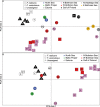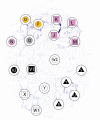Divergence within and among Seaweed Siblings (Fucus vesiculosus and F. radicans) in the Baltic Sea
- PMID: 27525655
- PMCID: PMC4985153
- DOI: 10.1371/journal.pone.0161266
Divergence within and among Seaweed Siblings (Fucus vesiculosus and F. radicans) in the Baltic Sea
Abstract
Closely related taxa provide significant case studies for understanding evolution of new species but may simultaneously challenge species identification and definition. In the Baltic Sea, two dominant and perennial brown algae share a very recent ancestry. Fucus vesiculosus invaded this recently formed postglacial sea 8000 years ago and shortly thereafter Fucus radicans diverged from this lineage as an endemic species. In the Baltic Sea both species reproduce sexually but also recruit fully fertile new individuals by asexual fragmentation. Earlier studies have shown local differences in morphology and genetics between the two taxa in the northern and western Bothnian Sea, and around the island of Saaremaa in Estonia, but geographic patterns seem in conflict with a single origin of F. radicans. To investigate the relationship between northern and Estonian distributions, we analysed the genetic variation using 9 microsatellite loci in populations from eastern Bothnian Sea, Archipelago Sea and the Gulf of Finland. These populations are located in between earlier studied populations. However, instead of bridging the disparate genetic gap between N-W Bothnian Sea and Estonia, as expected from a simple isolation-by-distance model, the new populations substantially increased overall genetic diversity and showed to be strongly divergent from the two earlier analysed regions, showing signs of additional distinct populations. Contrasting earlier findings of increased asexual recruitment in low salinity in the Bothnian Sea, we found high levels of sexual reproduction in some of the Gulf of Finland populations that inhabit extremely low salinity. The new data generated in this study supports the earlier conclusion of two reproductively isolated but very closely related species. However, the new results also add considerable genetic and morphological complexity within species. This makes species separation at geographic scales more demanding and suggests a need for more comprehensive approaches to further disentangle the intriguing relationship and history of the Baltic Sea fucoids.
Conflict of interest statement
Figures





References
-
- Mayr E. 1963. Animal species and evolution Cambridge, MA: Harvard University Press
-
- Coyer JA, Hoarau G, Stam WT, Olsen JL. Hybridization and introgression in a mixed population of the intertidal seaweeds Fucus evanescens and F. serratus. J Evol Biol. 2007; 20: 2322–33. - PubMed
MeSH terms
LinkOut - more resources
Full Text Sources
Other Literature Sources
Miscellaneous

